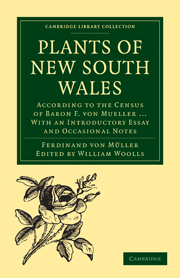 Plants of New South Wales
Plants of New South Wales REMARKS ON THE FLORA OF NEW SOUTH WALES
Published online by Cambridge University Press: 05 July 2011
Summary
In considering the Flora of New South Wales as a portion of the Australian plants, now known to number nearly 9,000 species, it may be observed that many changes in the vegetation have occurred since the foundation of the Colony in 1788; that some plants have become rare in the localities in which they were first procured; that others once common in the neighbourhood of Sydney and Parramatta have disappeared before the progress of cultivation; and further, that species from various parts of the world, some introduced accidentally and some for industrial purposes, have taken the place of the primeval forests.
The Flora of New South Wales, therefore, has undergone great changes since the beginning of the century. It is not now what it was at the period when the illustrious Robert Brown wrote his “Prodromus Florœ Novœ-Hollandiœ et Insulœ Van Diemen, and it is certain that before another century greater changes may be anticipated.
In 1805 the whole population of New South Wales was little more than 7,000, and the immediate neighbourhood of Sydney was occupied by the primitive vegetation. Now, according to the last Census, the city and suburbs alone contain 250,000 inhabitants, and extend over 2,000 acres of ground, whilst substantial and in some instances splendid buildings, in 121 miles of streets, cover the area where the early botanists (especially Surgeon-General White) collected their specimens of Eucalypts and Proteads.
- Type
- Chapter
- Information
- Plants of New South WalesAccording to the Census of Baron F. von Mueller ... With an Introductory Essay and Occasional Notes, pp. 1 - 14Publisher: Cambridge University PressPrint publication year: 2010First published in: 1885


